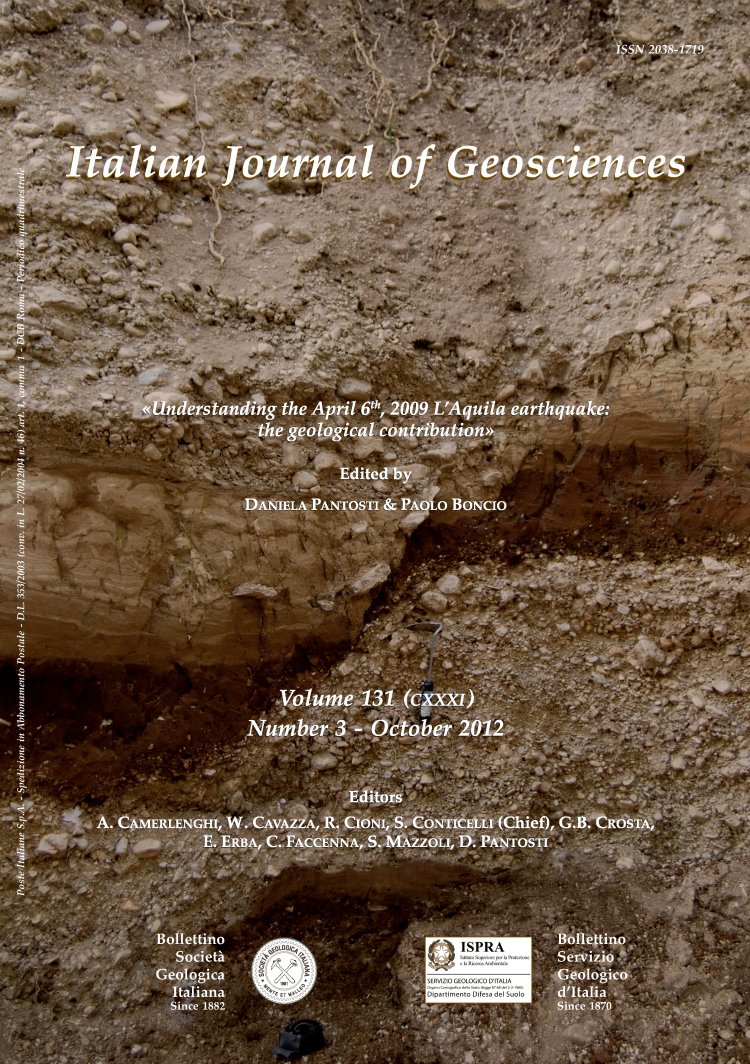
From surface geology to aftershock analysis: Constraints on the geometry of the L'Aquila 2009 seismogenic fault system
Giusy Lavecchia(*), Federica Ferrarini(*), Francesco Brozzetti(*), Rita De Nardis(*), (**), Paolo Boncio(*) & Lauro Chiaraluce(***)
(*) Laboratorio di Geodinamica e Sismogenesi, Dipartimento di Scienze P.U.T., Università «G. d'Annunzio», Campus Universitario - 66013 Chieti Scalo, Italy. E-mail: glavecchia@unich.it
(**) Dipartimento della Protezione Civile, Roma, Italy.
(***) Istituto Nazionale di Geofisica e Vulcanologia, Rome, Italy.
Volume: 131 (2012) f.3
Pages: 330-347
Abstract
The aim of this study is the definition of the geometry and structural style of the extensional fault system involved during the L'Aquila 2009 seismic sequence. The surface tectonic setting of the late Quaternary faults in the epicentral areas (i.e., the Paganica, Mt. Gorzano and Montereale faults in northwestern Abruzzo) was defined by integrating data from the literature with original field work. The geometry of the faults at depth was interpreted using high-resolution aftershock distributions (based on a dataset covering 6 April to 27 December 2009, Ml ≥?1.9). The 3D fault model was reconstructed through 39 sections variously oriented across the epicentral area and represented in a map view as depth contour lines.
Consistent geometric and kinematic correlations between the geological and seismological data were observed. The seismic sequence reactivated four well-distinguished fault sources differing in geometry, size and the degree of involvement. In order of importance, these sources may be ranked as follows: 1) the SW-dipping Paganica fault system activated during the 6 April mainshock (Mw 6.1/6.3) from the surface to a depth of ~10.5 km (along-strike length, L, 21 km; surface rupture length 13 km); 2) the NE-dipping hidden Ocre source activated during the strongest aftershock (9 April, Mw 5.4/5.5) at depths between 11 km and 16 km; 3) the WSW-dipping Mt. Gorzano fault activated by four relevant aftershocks (6 to 13 April, Mw ~5.0 to 5.5) at depths between 6 km and 12 km; 4) the WSW-dipping Montereale fault system and its continuation into the S-dipping Mt. San Franco fault activated at depths between 6 km and 10 km in a large number of minor events with Mw up to 3.6.
The hypocentre of the 6 April main event is sited at a depth of ~9.5 km close to the intersection line between the SW-dipping Paganica fault and the S-dipping Mt. Stabiata fault, suggesting that the fault plane complexities (in this case, the sharp bend of the fault strike) may represent a favoured site for earthquake nucleation. The L'Aquila 2009 seismic sequence did not reactivate the entire surface of the involved faults. Nevertheless, on the basis of other geological and seismological constraints, the overall fault extent is schematically reconstructed and parameterised. Some considerations related to the structural style of the intra-Apennine Quaternary extensional structures and their patterns at depth are advanced.
Keywords
Normal faults, structural setting, aftershock distribution, seismogenic sources, L'Aquila seismic sequence, Central Italy.
Get Full Text Supplementary Material